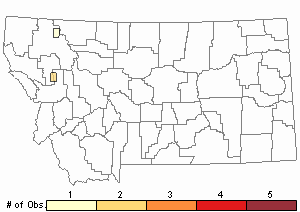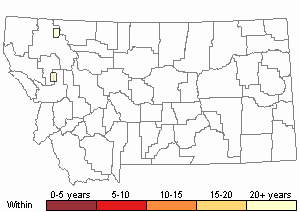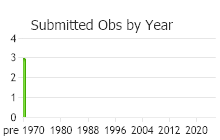View in other NatureServe Network Field Guides
NatureServe
Montana
Utah
Wyoming
Idaho
Wisconsin
British Columbia
South Carolina
Yukon
California
New York
Fascicled Racomitrium Moss - Codriophorus fascicularis
Other Names:
A Torncap Moss,
Racomitrium fasciculare
General Description
Plants: Growing in crowded to open clumps or large mats (FNA 2007), the shoots upright or creeping (Lawton 1971), brownish with yellow or olive tones, green sometimes with yellow tones, or dark brown to blackish above, dark brown to black below, not shiny. Stems generally to 10 cm, rarely to 20 cm, frequently with small, short branches resembling tufts, sometimes lending a knobby appearance to the plant; not possessing a central strand (FNA 2007).
Leaves: Upright and a little curved when dry, loosely upright when wet (Crum & Anderson et al. 1981) curved to straight, 1.5-4 mm in length and 0.5-1.5 mm in width, slenderly lance-shaped to lance-shaped with ovate or linear tendencies, slowly narrowing to an acumen (FNA 2007), cupped apically, keeled at mid-leaf (Lawton 1971); acumen acute or with a slim, rounded end, smooth; margins smooth, curved to tightly rolled back and down along both edges; costa running ca 3/4 of the leaf length, forked only at the tip, lying at the bottom of a somewhat deep groove (which is sometimes partially obscured by the infolded leaf base) (FNA 2007).
Leaf Cells: Margins 1 cell-layer thick, costa 2 cell-layers thick its full length (FNA 2007), rarely 3 layers near the base (Lawton 1971), in X-section the costa is flat on the ventral or inner leaf surface, and somewhat flat to slightly curved on the dorsal or outer leaf surface; laminal cells quadrangular and long, thick-walled and wavy throughout; basal laminal cells differentiated to create a pellucid border (FNA 2007); upper leaf cells rarely shorter than 3:1 (Lawton 1971).
Range Comments
North American Range
AK to NT, s to OR, ID, and MT, isolated in the mountains of CO, ON to NL and NS, sw to NY, also MI and MN (FNA 2007). Known in Montana from Flathead County (Elliott 2016).
Observations in Montana Natural Heritage Program Database
Number of Observations: 3
(Click on the following maps and charts to see full sized version)
Map Help and Descriptions
Relative Density

Recency


 (Observations spanning multiple months or years are excluded from time charts)
(Observations spanning multiple months or years are excluded from time charts)
Habitat
In sheltered or open habitats (FNA 2007), on acidic rocks (Crum & Anderson et al. 1981) and rocky bluffs or outcrops near streams and lakes, frequently where sometimes sprayed or inundated with water, seeps, less often on tree bases, logs floating in water, and wood shingle rooftops. Elevation: 0-13,450 feet (FNA 2007).
Reproductive Characteristics
Dioicous. Interior perichaetial leaves lance-shaped to elliptic, yellowish translucent throughout. Seta typically 3-8 mm tall, russet to brown with black tones (FNA 2007), spiraled clockwise, sometimes very slightly so (Lawton 1971). Capsule generally 1.2-2.5 mm in length (up to 3.1 mm), shiny and brown, exserted; peristome teeth russet, thickly covered with tiny, sharp papillae, divided nearly to the bottom into 2 lobes (FNA 2007). Calyptra with papillae in the distal half (Crum & Anderson et al. 1981).
Stewardship Responsibility
References
- Literature Cited AboveLegend:
 View Online Publication
View Online Publication Crum, H.A. and L.E. Anderson. 1981. Mosses of Eastern North America. 2 volumes. Columbia University Press, New York. 1328 pp.
Crum, H.A. and L.E. Anderson. 1981. Mosses of Eastern North America. 2 volumes. Columbia University Press, New York. 1328 pp. Elliott, J.C. and A.K. Pipp. 2018. A Checklist of Montana Mosses (1880-2018). Updated 3 January, 2020. Montana Natural Heritage Program, Helena, Montana. 73 pp.
Elliott, J.C. and A.K. Pipp. 2018. A Checklist of Montana Mosses (1880-2018). Updated 3 January, 2020. Montana Natural Heritage Program, Helena, Montana. 73 pp. Flora of North America Editorial Committee, eds. 2007. Flora of North America North of Mexico. Volume 27. Bryophytes: Mosses, Part 1. Oxford University Press, Inc., NY. xxi + 713 pp.
Flora of North America Editorial Committee, eds. 2007. Flora of North America North of Mexico. Volume 27. Bryophytes: Mosses, Part 1. Oxford University Press, Inc., NY. xxi + 713 pp. Lawton, E. 1971. Moss Flora of the Pacific Northwest. Hattori Botanical Laboratory. Japan: Yamabuki-cho, Shinjuku-ku, Tokyo. 362 pages plus appendices.
Lawton, E. 1971. Moss Flora of the Pacific Northwest. Hattori Botanical Laboratory. Japan: Yamabuki-cho, Shinjuku-ku, Tokyo. 362 pages plus appendices.
- Additional ReferencesLegend:
 View Online Publication
View Online Publication
Do you know of a citation we're missing? Elliot, J. C. 1993. Second checklist of Montana mosses. Unpublished report. U.S. Forest Service, Region 1. Missoula, MT. 45 pp.
Elliot, J. C. 1993. Second checklist of Montana mosses. Unpublished report. U.S. Forest Service, Region 1. Missoula, MT. 45 pp. Lawton, E. 1971. Keys for the Identification of the Mosses on the Pacific Northwest. Reprinted from 'Moss Flora of the Pacific Northwest'. Published as Supplement No. 2 of the Journal of the Hattori Botanical Laboratory. Nichinan, Miyazaki, Japan. 66 pp.
Lawton, E. 1971. Keys for the Identification of the Mosses on the Pacific Northwest. Reprinted from 'Moss Flora of the Pacific Northwest'. Published as Supplement No. 2 of the Journal of the Hattori Botanical Laboratory. Nichinan, Miyazaki, Japan. 66 pp. Malcolm, B., N. Malcolm, J. Shevock, and D. Norris. 2009. California Mosses. Nelson, New Zealand: Micro-Optics Press. 430 pp.
Malcolm, B., N. Malcolm, J. Shevock, and D. Norris. 2009. California Mosses. Nelson, New Zealand: Micro-Optics Press. 430 pp. Smith, A.J.E. 1980. The Moss Flora of Britain and Ireland. Cambridge University Press, Cambridge. 705 pp.
Smith, A.J.E. 1980. The Moss Flora of Britain and Ireland. Cambridge University Press, Cambridge. 705 pp.
- Web Search Engines for Articles on "Fascicled Racomitrium Moss"





